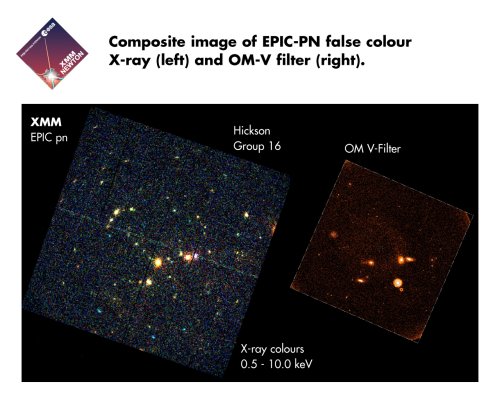XMM-Newton PN and OM First Light - HCG 16

Image and text courtesy of ESA
Composite image of EPIC-PN false colour X-ray (left) and OM-V filter (right)
X-ray image of the Hickson galaxy group taken with the XMM X-ray telescopes
compared to the optical image of the galaxies taken simultaneously with XMM's
Optical Monitor telescope. The ability to record images simultaneously over a
range of wavelengths is an important first for XMM, allowing new X-ray
discoveries to be placed immediately in the context of more familiar images
from the optical portion of the spectrum.
Get the high resolution version.
Multiwavelength views of Hickson Group 16
The HCG-16 viewed by EPIC and by the Optical Monitor in the visible and ultraviolet wavelengths is one of approximately a hundred compact galaxy clusters listed by Canadian astronomer Paul Hickson in the 1980s. The criteria for the Hickson cluster groups included their compactness, their isolation from other galaxies and a limited magnitude range between their members. Most Hicksons are very faint, but a few can be observed with modest aperture telescopes.
Galaxies in Hickson groups have a high probability of interacting. Their study has shed light on the question of galactic evolution and the effects of interaction. Investigation into their gravitational behaviour has also significantly contributed to our understanding of "dark matter", the mysterious matter that most astronomers feel comprises well over 90% of our universe.
Observation of celestial objects from space over a range of X-ray, ultraviolet and visible wavelengths, is a unique feature of the XMM-Newton mission. The EPIC-PN view of the Hickson 16 group shows a handful of bright X-sources and in the background more than a hundred faint X-ray sources that XMM-Newton is revealing for the first time.
Juxtaposing the X-ray view of HCG 16 with that of the Optical Monitor reveals one of the great strengths of XMM-Newton in being able to routinely compare the optical, ultraviolet and X-ray properties of objects.
Many of the X-ray sources are revealed as elongated "fuzzy blobs" coincident with some of the optical galaxies. Routine access to ultraviolet images is a first for the mission, allowing astronomers to learn much more about individual objects. Obtaining a ratio of the brightness of individual sources seen with different filters ("filter spectroscopy") gives indications on their temperature and composition. Using XMM-Newton to search for variability from sources such as these will enable astronomers to hunt for those elusive black holes thought to lurk at the centres of many galaxies.
"The performance of our instrument is very much as we expected" says Keith Mason, Principal Investigator for the Optical Monitor. "We have worked for over a decade on this mission and it is very exciting having the first data. And the pictures really show all the value of the multi-wavelength approach of the XMM design."
If you have any questions concerning XMM-Newton send email to xmmhelp@athena.gsfc.nasa.gov



